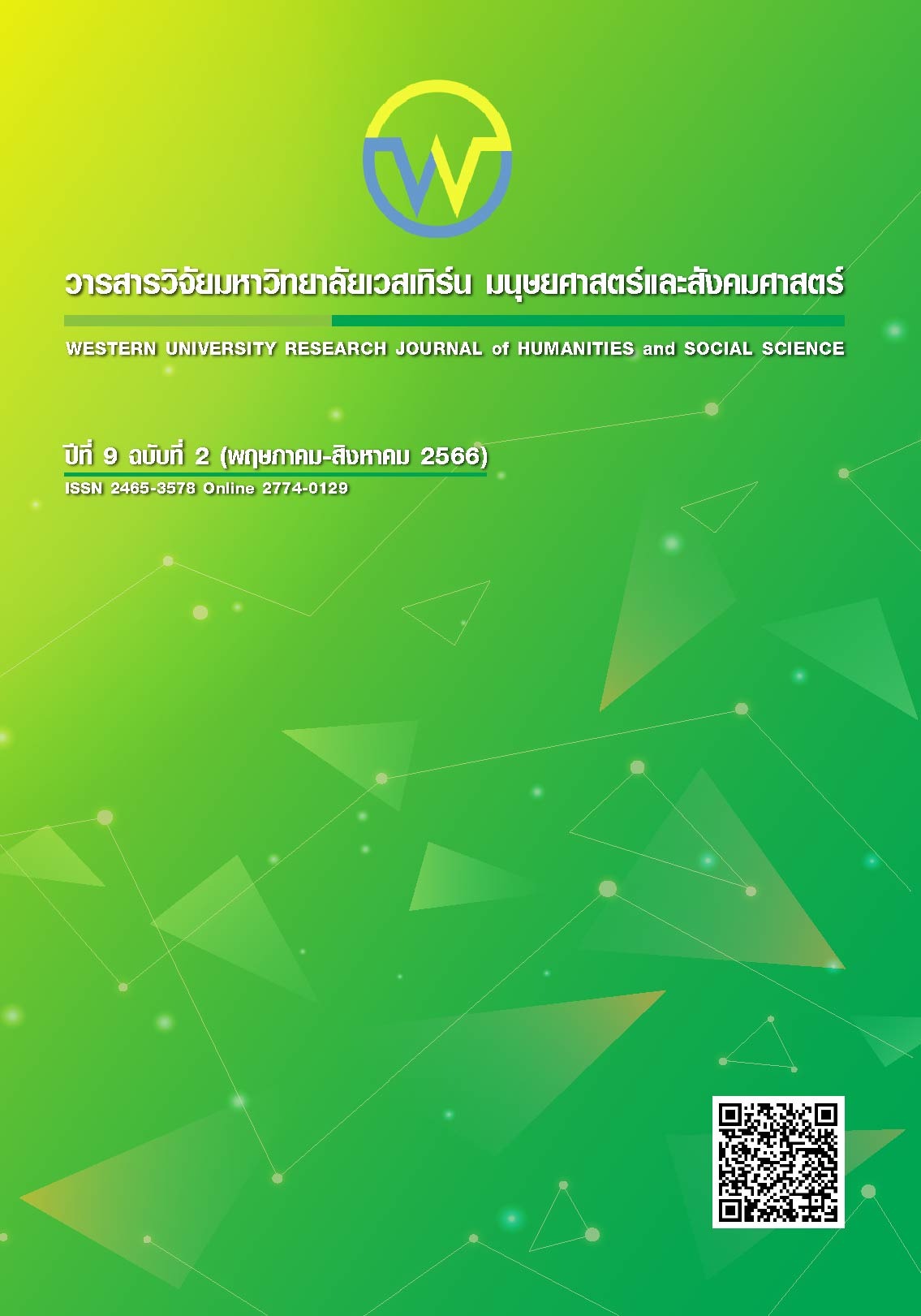การพัฒนาทักษะความคิดสร้างสรรค์และนวัตกรรม และเจตคติต่อการจัดการเรียนรู้ตามแนวคิดสะตีมศึกษา ของนักเรียนชั้นมัธยมศึกษาตอนปลาย
Main Article Content
บทคัดย่อ
การวิจัยนี้มีวัตถุประสงค์ 1) เพื่อเปรียบเทียบทักษะความคิดสร้างสรรค์และนวัตกรรมของนักเรียนชั้นมัธยมศึกษาตอนปลาย ก่อนและหลังได้รับการจัดการเรียนการสอนตามแนวคิดสะตีมศึกษา และ 2) เพื่อศึกษาเจตคติต่อการจัดการเรียนรู้ตามแนวคิดสะตีมศึกษาของนักเรียนชั้นมัธยมศึกษาตอนปลาย กลุ่มเป้าหมายที่ใช้ในการวิจัยครั้งนี้ ได้แก่ นักเรียนชั้นมัธยมศึกษาปีที่ 5 โรงเรียนเมืองแพร่ อำเภอเมืองแพร่ จังหวัดแพร่ ในภาคเรียนที่ 2 ปีการศึกษา 2565 จำนวน 15 คน ที่ได้มาจากการเลือกแบบเจาะจง (Purposive sampling) เครื่องมือที่ใช้ในการวิจัย ได้แก่ 1) แผนการเรียนรู้ตามแนวคิดสะตีมศึกษา เรื่องกรด-เบส จำนวน 4 แผนการจัดการเรียนรู้ 15 ชั่วโมง 2) แบบวัดทักษะความคิดสร้างสรรค์และนวัตกรรมของนักเรียนชั้นมัธยมศึกษาตอนปลาย และ 3) แบบวัดเจตคติต่อการจัดการเรียนรู้ตามแนวคิดสะตีมศึกษาของนักเรียนชั้นมัธยมศึกษาตอนปลาย สถิติที่ใช้ในการวิเคราะห์ข้อมูล ได้แก่ ร้อยละ ค่าเฉลี่ย ค่าความเบี่ยงเบนมาตรฐาน และสถิตินอนพาราเมตริก (Nonparametric Statistics) ใช้วิธีทดสอบแบบ The Wilcoxon signed – rank test ผลการวิจัยพบว่า 1) ทักษะความคิดสร้างสรรค์และนวัตกรรมของนักเรียนชั้นมัธยมศึกษาตอนปลายหลังได้ที่ได้รับการจัดการเรียนการสอนตามแนวคิดสะตีมศึกษาสูงกว่าก่อนเรียน อย่างมีนัยสำคัญทางสถิติที่ระดับ .05 2) เจตคติต่อการจัดการเรียนรู้ตามแนวคิดสะตีมศึกษาของนักเรียนชั้นมัธยมศึกษาตอนปลาย โดยใช้การจัดการเรียนรู้ตามแนวคิดสะตีมศึกษาอยู่ในระดับมาก ( = 3.56,
= .20)
Article Details

This work is licensed under a Creative Commons Attribution-NonCommercial-NoDerivatives 4.0 International License.
References
เครือฟ้า แก้วคุ้ม. (2566). ความคิดสร้างสรรค์กับการพัฒนาการเรียนการสอนในระดับการศึกษาขั้นพื้นฐาน. วารสารดุษฎีบัณฑิตทางสังคมศาสตร์, 13(1), 91-103.
จิตติรัตน์ แสงเลิศอุทัย. (2565). ทฤษฎีการเรียนรู้สู่การพัฒนาบทเรียนออนไลน์. วารสารวิชาการ มหาววิทยาลัยราชภัฏกาญจนบุุรี, 11(1), 3-13.
ชานนท์ รังสีสวัสดิ์. (2561). การสร้างแบบจำลองมาริมบาเพื่อการเรียนการสอน วิชาทักษะดนตรีของนักเรียนระดับ ชั้นมัธยมศึกษาโดยใช้แนวคิดสัมพันธ์เชื่อมโยงของธอร์นไดค์. วารสารศิลปกรรมศาสตร์ มหาวิทยาลัยศรีนครินทรวิโรฒ. 22(1), 12-20.
ธัญชนก ทาระเนตร. (2564). ผลการจัดการเรียนรู้ตามแนวคิดสะตีมศึกษาที่มีต่อความคิดสร้างสรรค์ทางวิทยาศาสตร์แลผลสัมฤทธิ์ทางการเรียนวิทยาศาสตร์ เรื่องเทคโนโลยีทางดีเอ็นเอของนักเรียนชั้นมัธยมศึกษาปีที่ 4. วารสารศึกษาศาสตร์ มหาวิทยาลัยนเรศวร, 24(4), 132-142.
มัสยา บัวผัน, สิราวรรณ จรัสรวีวัฒน์ และอาพันธ์ชนิต เจนจิต. (2563). ผลการจัดกิจกรรมการเรียนรู้ตามแนวคิดสะตีมที่มีต่อผลสัมฤทธิ์ทางการเรียนความคิดสร้างสรรค์ และเจตคติของนักเรียนชั้นประถมศึกษาปีที่ 4. วารสารครุศาสตร์จุฬาลงกรณ์มหาวิทยาลัย, 48(2), 303-324.
รัชนีพร ศรีรักษา ปริญญา เรืองทิพย์ และสิริกรานต์ จันทเปรมจิตต์. (2563). การพัฒนาโปรแกรมภาพตามหลักการของเกสตัลท์สำหรับเพิ่มความใส่ใจต่อเนื่องและความจำขณะทำงานในวัยผู้ใหญ่ตอนต้น. วารสารวิชาการธรรมทรรศน์, 20(3), 133-144.
วราวุฒิ อัมพุธ. (2564). การจัดการเรียนรู้เศรษฐศาสตร์แบบโครงงานธุรกิจสร้างสรรค์เพื่อพัฒนาผลิตภัณฑ์ภูมิปัญญาชาวบ้านของนักเรียนชั้นมัธยมศึกษา. วารสารสหวิทยาการเพื่อการพัฒนา มหาวิทยาลัยราชภัฏอุตรดิตถ์, 11(2), 105-115.
วิสูตร โพธิ์เงิน. (2560). STEAM ศิลปะเพื่อสะเต็มศึกษา: การพัฒนาการรับรู้ความสามารถและแรงบันดาลใจให้เด็ก. วารสารครุศาสตร์, 45(1), 320-334.
ศิริลักษณ์ อิสณพงษ์, ภัทรภร ชัยประเสริฐ และสมศิริ สังห์ลพ. (2563). การจัดการเรียนรู้ตามแนวคิดสะตีมศึกษาที่มีต่อผลสัมฤทธิ์ทางการเรียน ความคิดสร้างสรรค์ทางวิทยาศาสตร์และเจตคติต่อวิชาเคมีของนักเรียนชั้นมัธยมศึกษาปีที่ 4. วารสารศึกษาศาสตร์ มมร, 9(1), 37-47.
สถาบันส่งเสริมการสอนวิทยาศาสตร์และเทคโนโลยี. (2561). ผลการประเมิน PISA 2018 การอ่าน คณิตศาสตร์และวิทยาศาสตร์. กรุงเทพฯ.
สรัญญา เนตรธานนท์. (2563). กระบวนการเสริมสร้างทักษะการคิดวิเคราะห์สร้างสรรค์ ด้วยการจัดการเรียนรู้แบบสร้างสรรค์ด้วยปัญญา. วารสารสหศาสตร์ศรีปทุม ชลบุรี, 6(3), 20-31.
สุชาดา ลดาวัลย์ และกฤตัชญ์ มีคำทอง. (2561). การจัดการเรียนรู้ภาษาอังกฤษให้กับผู้เรียนยุค Thailand 4.0. วารสารมหาวิทยาลัยมหามกุฏราชวิทยาลัย วิทยาเขตร้อยเอ็ด, 8(1), 308-317.
สุพรรณี บุญหนัก ธนวัฒน์ ชาวโพธิ์ และจักรกฤษณ์ โพดาพล. (2564). การศึกษา 4.0: กระบวนทัศน์การศึกษามุ่งสู่อนาคตประเทศ. วารสารวิจัยศรีล้านช้าง, 1(1), 41-53.
สุภัค โอฬาพิริยกุล. (2562). STEAM Education : นวัตกรรมการศึกษาบูรณาการสู่การจัดการเรียนรู้. วารสารวิจัยและพัฒนาหลักสูตร, 9(1), 1-16.
Aguilera, D. and Ortiz-Revilla, J. (2021). STEM vs. STEAM education and student creativity: A systematic literature review. Education Sciences, 11(7), 331.
Bruner, L. S. (1969). The process of education. Massachusetts: Hayward University Press Cambridge.
Perignat, E., & Katz-Buonincontro, J. (2019). STEAM in practice and research: An integrative literature review. Thinking skills and creativity, 31, 31-43.
Wicks, D., & Paulus Jr, M. J. (2022). 21st Century Learning Skills and Artificial Intelligence. AI, Faith, and the Future: An Interdisciplinary Approach, 152.
Yakman, G., & Lee, H. (2012). Exploring the exemplary STEAM education in the US as a practical educational framework for Korea. Journal of the Korean Association for Science Education, 32(6), 1072-1086.

